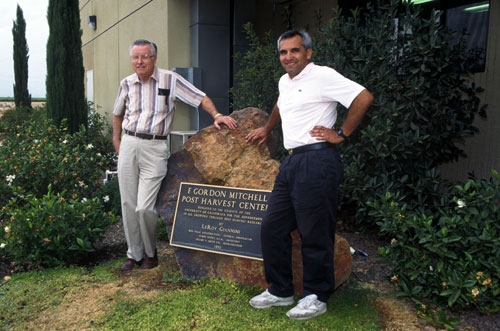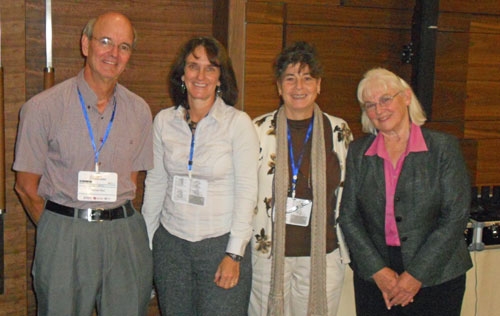Posts Tagged: postharvest
‘Fuyu’ persimmons are sensitive to chilling injury.
During this season, Carlos Crisosto, CE postharvest physiologist, Kearney Agricultural Research & Extension Center and the UC Davis Plant Sciences Department, is often asked how to determine maturity, as well as best practices for harvesting and storage of ‘Fuyu’ persimmons. ‘Fuyu’ persimmons completely lose their astringency before harvest and can be consumed while they are still firm. Harvest time is usually determined according to the fruit color and size. The best method of harvesting is to clip the fruit from the tree with small clippers (orange clippers), leaving the calyx attached to the fruit. It is also possible to snap the fruit from the tree but this practice is not recommended as it may injure the fruit and adjoining shoot. During harvesting and packaging, fruit must be handled carefully to avoid bruising, which can result in undesired marking as the fruit ripens. Penicillium, Botrytis and Cladosporium fungi may infect ‘Fuyu’ persimmons during storage, especially, if the skin has been damaged during postharvest handling.
‘Fuyu’ persimmons are very sensitive to chilling injury which is expressed by accelerated fruit softening, flesh browning, and translucency (jelly-like consistency) during and after storage. These symptoms appear more severe after 2-4 days at 68oF (20oC) following storage. Chilling injury is more rapid and severe at 41oF (5oC), especially, combined with ethylene exposure. Previous studies led by Dr. Kader demonstrated that exposure to 1 and 10 ppm ethylene at 68oF (20oC) resulted in accelerated softening to less than 4 pound-force ( the limit for marketability) after 6 and 2 days, respectively. Exposure to 1 and 10 ppm ethylene at 41oF (5oC) will induce fruit firmness below 4 pound-force (soft) after 15 and 8 days, respectively. Therefore, the use of 1-MCP, ethylene removal and/or exclusion of ethylene during packaging and storage at 32oF (0oC) operations is strongly recommended for maintaining quality and extending ‘Fuyu’ persimmon storage life potential.

A ‘Fuyu’ persimmon is firm when mature.
Central Valley Postharvest Newsletter archives and other resources are available on the web.
To help growers, packers, shippers and handlers of Central Valley crops, Carlos Crisosto, CE postharvest physiologist, Kearney Agricultural Research & Extension Center and the UC Davis Plant Sciences Department, published the Central Valley Postharvest Newsletter (CVPN). CVPN archives contain summarized information relevant to fresh fruit growers, packers, shippers and handlers. The archives are available from the UC KARE and UC Davis websites.
Other online resources that Crisosto recommends include:
- The UC Davis Fruit & Nut Research & Information
- A draft version of the forthcoming revision to USDA Agricultural Handbook 66 (Commercial Storage of Fruits, Vegetables and Florist and Nursery Stocks)
- Postharvest information site of the Food and Agriculture Organization of the United Nations
- World Vegetable Center Postharvest Information
- Postharvest Education Foundation (training in postharvest technology)
- Production and Handling of Avocado
- University of Florida Postharvest Group, including citrus resources
- University of Florida Citrus Resources
- California Citrus Research Board – supported research reports
- Washington State University Postharvest Information Network (emphasis on apple, pear, and cherry)
- North Carolina State University postharvest publications
- Sydney Postharvest Laboratory information
- Chain of Life Network® website with recommendations for the care, handling and marketing of floral crops

Carlos Crisosto examining a fresh market peach crop in a Central Valley orchard.
In memoriam: F. Gordon Mitchell
Namesake of the UC Kearney Agricultural Research and Extension Center’s postharvest center, F. Gordon Mitchell, died in February. He was 88.
Mr. Mitchell began his distinguished career with the University of California Cooperative Extension immediately following graduation from college in 1949. He was the viticulture advisor in San Joaquin County for eight years before taking a position as statewide pomology specialist at UC Davis in 1957.
During his career, Mr. Mitchell’s work resulted in an industry-wide change to rapid cooling methods, the improvement in fruit packing efficiency, and greater understanding among farmers about the requirements of produce during the postharvest time period. He worked primarily on plums, peaches, nectarines, cherries, pears, strawberries, applies and kiwifruit, however, during his 42-year career conducted research on virtually all pomological commodities.
Mr. Mitchell retired in 1991. When Dinuba farmer/packer LeRoy Giannini contributed funds to build the new postharvest laboratory at Kearney, he suggested naming the building after Mr. Mitchell. On Feb. 8, 1993, the facility was christened the F. Gordon Mitchell Postharvest center.
Emeritus UC Cooperative Extension specialist Jim Thompson of the UC Davis Department of Biological and Agricultural Engineering said Mr. Mitchell worked tirelessly with the California agriculture industry to improve the market for the state’s fresh fruits and tree nuts.
“He developed the early concepts and standards for handling California Granny Smith and Fuji apples, kiwifruit, and pistachio nuts,” Thompson said. “When the tree fruit industry had questions about postharvest issues, their first phone call was to Gordon."
UC Cooperative Extension postharvest horticulturist Mary Lu Arpaia, who is based at the UC Kearney Agricultural Research and Extension Center, counts Mr. Mitchell as a mentor and guidepost for her career.
“Sometimes the best things in life that happen to you are unplanned,” Arpaia said about taking a job in the UC Davis postharvest lab when she was a graduate student. “That job was with Gordon and that was serendipity. When I think back on that one event I know it was one of the most important events in my graduate career and subsequent adventures in life.”
Arpaia said Mr. Mitchell’s work with his colleagues with forced air cooling and packaging established him to be a leader, “albeit a soft spoken one,” in the field of postharvest handling.
Mr. Mitchell was a Davis resident for 55 years. The family obituary described him as a gentle and devoted soul who took great pride in his faith, family and career. Mr. Mitchell is survived by his sister, two sons, a daughter and six grandchildren.

Gordon Mitchell (left) with post harvest scientist Carlos Crisosto in front of the F. Gordon Mitchell Postharvest Center at Kearney.
Balkans farmers show keen interest in postharvest science
UC subtropical horticulture specialist Mary Lu Arpaia, who is based at the Kearney Agricultural Research and Extension Center, was one of four UC specialists who traveled to Sarajevo Oct. 24-28 at the request of local officials to present a condensed version of the UC Postharvest Technology Short Course. Nearly 100 participants from 11 countries attended the program, which included lectures and a field tour. Simultaneous translation was offered in Bosnian and Russian.
“To me it was a very interesting experience,” Arpaia said. “The participants were very engaged in the course and asked lots of questions that were spot-on in terms of sharing practical information. They were very keen to get information on the ‘how to’ and solving practical situations."
Mary Reed of the UC Postharvest Technology Center said interest in the short course was remarkable given that the first estimate from planners was for 25 participants.
“Interest just kept growing and growing as word got around,” Reed said. “Given the challenges of traveling in the region, acquiring visas, and obtaining agency permissions, the participants really had to overcome significant obstacles in order to attend.”
Arpaia said the four-days she spent with Eastern European farmers in an area that suffered bitter ethnic conflicts in the 1990s also made a profound personal impression.
“I had been aware of the war in the Balkans but never fully appreciated the impact of that war on people’s lives,” she said. “You can still see the physical scars of the war – mortar shell scars on buildings, burned and abandoned buildings – and, more dramatically, hear the angst of the people when they talked about those times. It is another example to reflect upon in terms of how lucky we are in the U.S. and that we need to forever be vigilant not to allow animosities to fester due to ethnicity, religion etc.”

UC Davis Postharvest Technology Center instructors to the Balkans Regional Postharvest Technology training: (L-R) Drs. Michael Reid, Elizabeth Mitcham, Mary Lu Arpaia, Marita Cantwell.